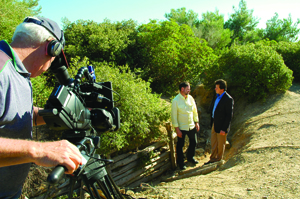Daniel Reynaud
One of the key elements of the Anzac legend is its secular status. The Anzacs are generally held not to have been interested in religion, and the Anzac legend itself has become a kind of national secular religion, with its own dogmas, sacred places and rituals. There has been some scholarly research on the topic, but very little in the last twenty years. Scholars have noted the paucity of information, as the soldiers left little evidence of an interest in religion.

Associate Professor Daniel Reynaud (left) and It Is Written Oceania speaker and director Pr Gary Kent being filmed on location at The Neck, Gallipoli.
I began my research by examining the diaries and letters of the chaplains, as being the most likely source of such information, and then moved on to the papers of soldiers. While the absolute proportion of soldiers writing about spiritual matters is relatively small, my research indicates that this in itself should not be taken as a characteristically Australian lack of interest in spiritual matters. Even a chaplain like Andrew Gillison, whose life was noted by many to be saintly and was almost universally revered by his battalion, left a Gallipoli diary with remarkably few religious references.
In fact, a book on British and American Great War soldiers and religion revealed that overt religious comments are equally rare; hence the first conclusion I came to was that the Australian soldier was not less religious than his British or American counterpart.
The impact of particular chaplains was very strong. Some men like Father Michael Bergin, Andrew Gillison, T.P. Bennett, and even YMCA worker Oswalt Chambers (still influential today through his posthumous books) had a huge influence on Australian soldiers and won their deep affection. The larger-than-life Salvation Army chaplain William McKenzie developed a popularity almost unrivalled, being considered by some well-placed observers to have been the most popular man in the AIF, with the possible exception of General Birdwood or Prime Minister Billy Hughes. His story has been published, but with frequent errors of fact, and I am aiming to develop a full biography of this fascinating and influential man.
In the course of my research I stumbled across a reference to a Seventh-day Adventist soldier in Egypt prior to the Gallipoli campaign. This triggered a search for who he might be, but although I have located about fifty-five Seventh-day Adventist soldiers, I have still not been able to identify any SDA soldier who was in Egypt or on Gallipoli at that time. It also highlighted some other interesting anomalies: Seventh-day Adventists were encouraged not to get involved in the war, but even more interesting are the thirty-two Quakers who enlisted, despite the strongly pacifist nature of their faith. Other religions of interest include two Buddhists, three Sikhs, three Muslims and four Hindus.
This material is being developed into a number of scholarly articles, and eventually a book or two.
It Is Written Oceania has produced six television episodes based on Associate Professor Reynaud’s research. Daniel Reynaud wrote the scripts, served as historical consultant, and was interviewed on camera for all six episodes.
Share
